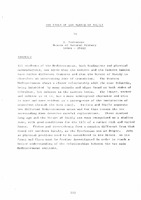| dc.description.abstract | All students of the Mediterranean, both biologists and physical oceanologists, now agree t ·hat the Western and the Eastern basins have rather different features and that the Strait of Sicily is there fore an interesting zone of transition. The Western Mediterranean shows a closer relationship with the near Atlantic, being inhabited by many animals and algae found on both sides of Gibraltar, but unknown in the Eastern basin. The latter, warmer: and saltier as it is , has a more subtropical character and this is more and more evident as a consequence of the immigration of organisms through the Suez canal . Tunisia and Sicily separate two different Mediterranean areas and for this reason the sea surrounding them deserves careful explor ations. These started long ago and the Strait of Sicily was soon recognized as a shallow zone, with good conditions for the life of a rather r ich and varied fauna. Fishes and invertebrata form a complex different from that found off northern Sicily, as the Tyrrhenian sea is deeper. Just as physical problems need to be c onsidered in the Strait , so its fauna and flora must be further investi gated in order to reach a better understanding of the relations hips between the two main Mediterranean sections. | |
